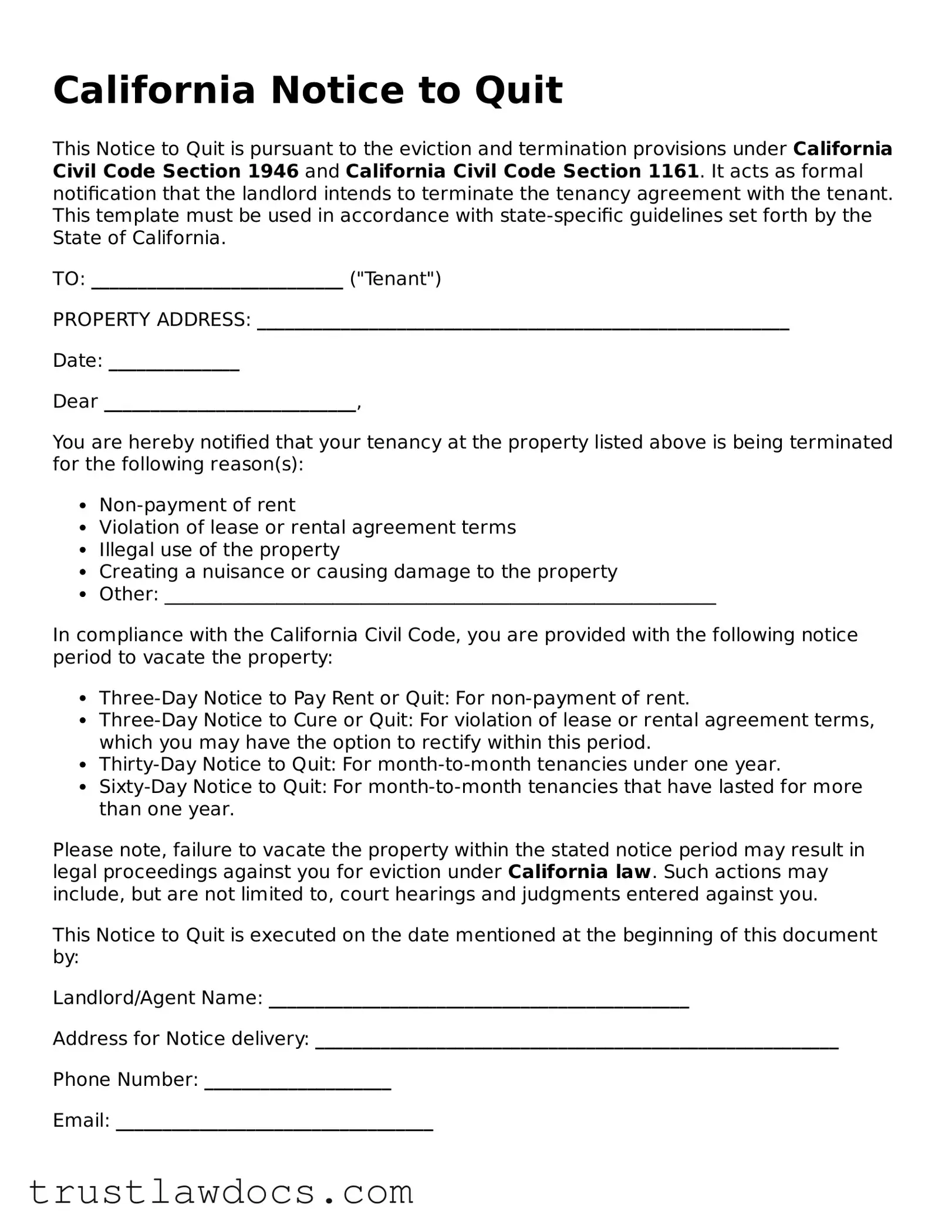What is a California Notice to Quit?
A California Notice to Quit is a formal document used by landlords to notify a tenant that they must vacate the rental property. It serves as a preliminary step before eviction proceedings can begin. The notice specifies the reason for eviction, such as non-payment of rent or violation of lease terms, and provides the tenant with a deadline to resolve the issue or leave the property.
When is it necessary to use a California Notice to Quit?
This notice is necessary whenever a landlord seeks to reclaim possession of their rental property due to a tenant's failure to comply with the terms of the lease agreement. Common reasons include non-payment of rent, causing damage to the property, or engaging in illegal activities on the premises. It's the first legal step a landlord must take to proceed with an eviction.
How much time does a tenant have to respond to a Notice to Quit in California?
The amount of time a tenant has to respond to a Notice to Quit in California varies depending on the reason for eviction. For non-payment of rent, tenants are usually given 3 days to pay or vacate. For lease violations, a 3-Day Notice is also typically provided, but for more severe breaches or when a tenant is given notice to leave without the possibility of correcting the issue, a 30-Day or 60-Day Notice may be required, especially if the tenant has lived at the property for a year or more.
Can a tenant legally dispute a Notice to Quit?
Yes, tenants can legally dispute a Notice to Quit by presenting their case in court. They may have valid defenses, such as arguing that the notice was improperly served, the eviction is discriminatory or retaliatory, or the landlord has failed to maintain the property in a habitable condition. Seeking legal counsel to understand one's rights is highly recommended.
What should a California Notice to Quit include?
A properly executed California Notice to Quit should include the tenant's name, the address of the rental property, the specific reason for the eviction, the date by which the tenant must correct the issue or vacate the property, and the landlord's signature. Clarity and specificity are crucial to ensure the notice is legally binding.
How should a Notice to Quit be delivered to the tenant?
The Notice to Quit can be delivered in person, either to the tenant directly or to a resident of suitable age at the property. Alternatively, it can be posted on the door of the rental unit and mailed to the tenant's last known address. This ensures the tenant cannot avoid receiving the notice by being absent from the property.
What happens if a tenant ignores a Notice to Quit in California?
If a tenant chooses to ignore a Notice to Quit, the landlord may proceed with filing an eviction lawsuit, known as an unlawful detainer suit, in court. This initiates formal legal proceedings to obtain a court order to remove the tenant from the property. Ignoring a Notice to Quit typically results in fewer options to resolve the issue and may lead to legal expenses and a potential eviction on one's record.
Are there different types of Notices to Quit in California?
Yes, there are several types of Notices to Quit in California, each tailored to specific situations. These include the 3-Day Notice for rent non-payment or lease violations, the 30-Day or 60-Day Notice for tenants who have been in the property for less than or more than one year, respectively, and a No Fault Eviction Notice for situations such as owner move-in or demolition of the property.
Can a landlord evict a tenant without a Notice to Quit in California?
No, California law requires landlords to provide a Notice to Quit before proceeding with an eviction. This notice serves as a legal prerequisite, ensuring tenants are aware of the eviction reason and have an opportunity to rectify the situation or vacate the premises. Bypassing this step can result in the eviction being deemed illegal.
Where can one find a template or form for a California Notice to Quit?
Templates for a California Notice to Quit can be found online through legal resources and websites specializing in landlord-tenant laws. Alternatively, legal assistance organizations, real estate professionals, and attorney offices can provide access to standardized forms that comply with California law, ensuring the notice meets all legal requirements.
